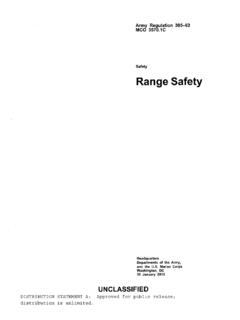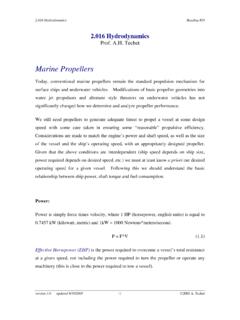Transcription of A Brief Introduction to Important Vessel ... - Marine Insight
1 A Quick Reference Resource for Deck Officers and Ship s Crew A Brief Introduction to Important Vessel Mooring Techniques Marine Insight A Brief Introduction to Important Vessel Mooring Techniques Publication date: Aug 2016 Editor : Raunek Kantharia Published by: Marine Insight Graphic Design: Anish Wankhede Copyright 2016 Marine Insight NOTICE OF RIGHTS All rights reserved. No part of this book may be rewritten, reproduced, stored in a retrieval system, transmitted or distributed in any form or means, without prior written permission of the publisher. NOTICE OF LIABILITY The authors and editors have made every effort possible to ensure the accuracy of the information provided in the book. Neither the authors and Marine Insight , nor editors or distributors, will be held liable for any damages caused either directly or indirectly by the instructions contained in this book, or the equipment, tools, or methods described herein.
2 3 Title of the book mooring mooring point or single buoy mooring or multi buoy mooring mooring mooring & Standing mooring 4 A Brief Introduction to Important Vessel Mooring Techniques Mooring is a procedure to make fast the ship with a fixed or a floating object ( Jetty, pier, ship, barge, buoy etc.) to held them together for various cargo operations. In other words- securing or confining of Vessel in a particular location. The mooring operation demands a high degree of teamwork both from ship s and port crew. It is of great importance that all crew involved in mooring operation are properly trained and equipped, and must have a clear understanding of the duties of fellow members, as well as their own role and responsibilities. What is Mooring of Ship? Image Courtesy: SK Shahin Anjum 1 5 To be a safe and efficient team on ship, the mooring operations must be properly planned. For large ships on tidal berths, mooring plans are developed and agreed prior to Vessel arrival, and roles and responsibilities of each crew and officers are explained.
3 The complete responsibility for coordinating the mooring operation lies with master of the ship (In case pilot is taking the lead, he will be responsible for the coordination) and not the shore/port mooring party. The port authority also plays an Important role to arrange the berth and equipment for ship to get alongside which also requires moving of cranes away from the area until the ship is along side or clear, or ensure cranes are in the ship s mid length area as the ship maneuvers near to the quayside. A Brief Introduction to Important Vessel Mooring Techniques 6 What happens when there is not enough space at the wharf for a number of ships or boats to be moored? Or what happens when there is a ramp at the stern of the ship (like a car carrier) that connects it to the hold? The answer is that the ship has to be moored perpendicular to the wharf with its stern transom (surface) lying parallel to the jetty.
4 Such end on to the quay berthing is called Mediterranean Mooring . Mediterranean mooring, also known as med mooring , is a technique for mooring a Vessel to pier at a perpendicular What is Mediterranean Mooring of Ship? Image Courtesy: Sudhai Hazell 2 A Brief Introduction to Important Vessel Mooring Techniques angle. The ship thus occupies less space as it is connected to a fixed length of pier along the width rather than its length. The disadvantage of Mediterranean mooring is that it is more likely to result in collisions and that it is not practical in deep water or in regions with large tides. Mediterranean mooring can be done in two ways. Now the boats or crafts like yacht can be berthed bow to or stern to with the wharf depending upon the convenience or preference of the crew but in both cases an anchor is dropped from the opposite end of the one that is approaching the jetty in such a way so that that the end remains fixed and the anchor can be hove up and hauled out.
5 CASE 1: (Berthing Stern to) At first the place where the ship s stern is to be brought alongside is located. A firsthand knowledge of the shore line is required, like if there is a protrusion or not at the underwater section or the bed is shallow or shoaled. 7 A Brief Introduction to Important Vessel Mooring Techniques 8 A Brief Introduction to Important Vessel Mooring Techniques In that case the stern first approach is aborted and the bow first approach is tried. For a Vessel having normal right handed propeller the wharf is best kept on the port side and the distance is kept more than seven ship s length. The ship is at first kept parallel to the berth and then it is brought astern. The point of berthing is now generally abeam. All through the astern movement, the rudder is kept to hard over port so as to get the maximum canting effect. As the ship falls astern, the bow will naturally cant to starboard due to transverse thrust.
6 The starboard anchor is dropped in such a way so that the scope (it s the ratio of the length of the anchor rode and the vertical distance from the bow of the Vessel to the bottom of the water or the bed) is 7:1 (approx). So if the sea bed is 10 m down from the bow, a distance of 70 m is required. Smaller crafts with shorter anchor chain will try to make this distance as much as practicable. The chain is let to fall free so that the anchor digs at the sea bed in the first attempt. It is ensured that there is no snag in the rode (it s the length of the anchor line or chain) and that there is enough length of the chain to reach the berth. 9 A Brief Introduction to Important Vessel Mooring Techniques The anchor must be dropped away from the other anchor lines or the lazy lines, which are used to retrieve heavy pre embedded bow lines substituting the anchor. Otherwise fouling of the anchor chains or these lines can be quite a cumbersome affair during sailing.
7 Meanwhile hand fenders are arranged along the sides to protect the hull of the ship/boats on a windy day from colliding with the other crafts that are docked already. The Vessel is slowly brought astern keeping in mind that the wind is not on-shore; otherwise the fall cannot be restricted. Offshore winds are of great help as they dampen the stern board movement and the Vessel will have a tendency to stop without much use of the ahead movements on the telegraph. When the wind is athwart, the first line ashore will be the one from the windward side. In this case if the wind pushes the starboard hull the starboard quarter line is to be sent ashore first. Then the other rope from the opposite end is thrown ashore and ensured that both the lines are doubled up , the lines are made to take a turn on the shore bollard and are sent on board. 10 A Brief Introduction to Important Vessel Mooring Techniques This helps the crew while hauling out as only casting one end of the line from on board the line can be retrieved with the winch without any shore assistance.
8 On a windy day the first shoreline is sent ashore by a small motorboat or a dingy so that the Vessel can be warped in with the help of its winches. While hauling in if the bow swings, corrective counter measures are taken with short kicks of forward movements and necessary helm or holding the anchor a bit, as the case may be. The lines ashore are fast in such a way that the angle between them is wide enough to restrict any swing of the stern due to any surge in the wave or wind. It is best to set another pair of lines across the stern to the shore. The boarding ramp is employed for the crew to step out from the stern. Also cars and trucks loaded in the car carriers can be loaded or unloaded. CASE 2 ( Berthing Bow to): Docking Bow to is much easier though as the pilot or the master has much more control over his ship as he steers in letting his stern anchor far off the berth so as it holds the 11 A Brief Introduction to Important Vessel Mooring Techniques stern during the stay.
9 12 A Brief Introduction to Important Vessel Mooring Techniques A line from each quarter is hitched to the chain aft to restrict any side wards play. Two lines are passed ashore from the port and starboard bow at a wide angle as in the previous case so as to make fast the bow to the jetty. This type of bow fast approach is done if there is an underwater shoal below the jetty or there is a protrusion. In both cases the anchor is snubbed when there is only a boat length difference between the quay and the bow or stern. Engines are also given accordingly so as to avoid any untoward collision. 13 A Brief Introduction to Important Vessel Mooring Techniques 14 What happens when there is a strong onshore wind and you have to berth a ship without the assistance of tugs to a pier or jetty that is not strong enough to bear the impact or is not sufficiently fendered ? In such situations, the master or the pilot takes the recourse of using the ship s anchor as well as the wires available on board in a specific way to minimize the impact of the fall.
10 This is done by a mooring ship in such a way where a Vessel is berthed alongside the quay by employing a stern mooring What is Baltic Mooring Of Ship? Image Courtesy: Roger Ross 3 A Brief Introduction to Important Vessel Mooring Techniques shackled to the offshore anchor cable in the region of the ganger length . When approaching the berth, the offshore anchor is deployed and the weight on the cable and the stern mooring act in unison to hold the Vessel just off the quay. Baltic mooring is a combination mooring of a Vessel alongside the berth which employs a stern mooring shackled to the offshore anchor cable in the region of the ganger length . When approaching the berth, the offshore anchor is deployed and the weight on the cable and the stern mooring act to hold the Vessel just of the quay. Baltic mooring is a safe option to berth a ship on a windy day. Now, there is a preparatory process to be undertaken before venturing for the Baltic moor: At first a 30 mm wire is passed from the poop deck on the offshore side from the outside of the hull and clear of any protrusions like the gangway, the pilot ladder etc.












